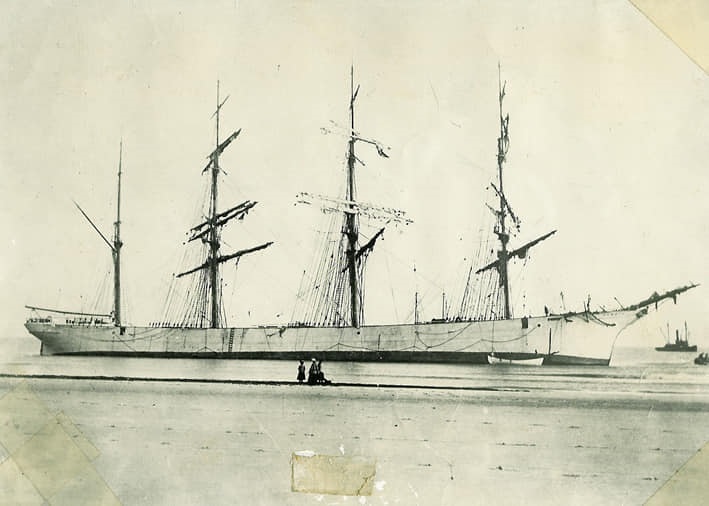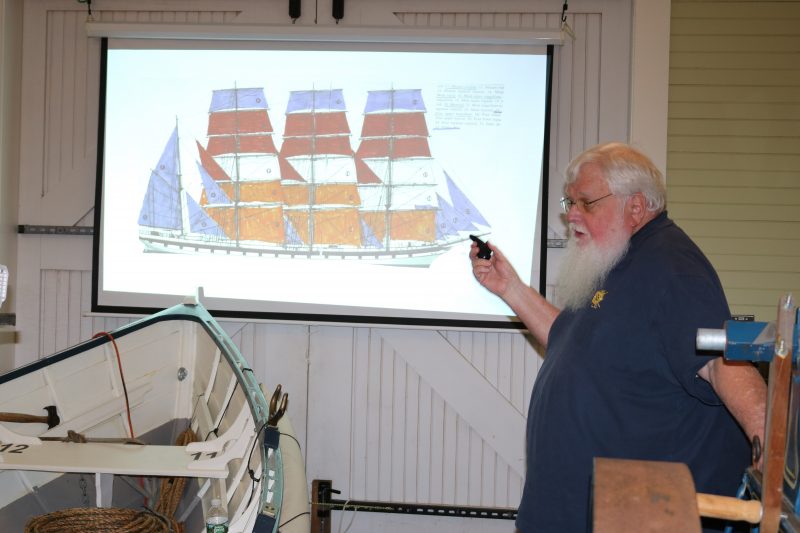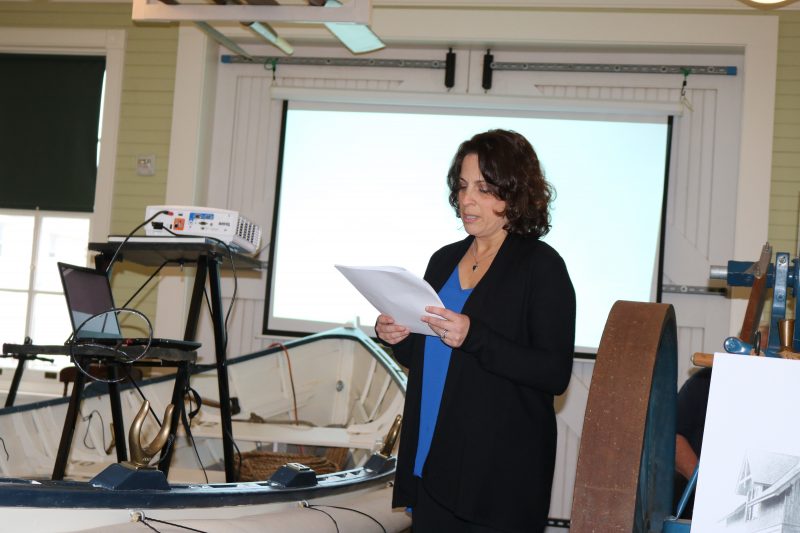Ocean City Life Saving Station volunteer Maryann Pionegro-Smith reads from a journal about the Sindia.
 By DONALD WITTKOWSKI
It was just a small piece of history, but the impact on Gail Powell was huge.
As she stared at the old Chinese silver coin resting in the palm of her hand, Powell uttered “absolutely incredible” as though she was looking at a priceless artifact.
Her fascination with the coin really had little to do with its origins in China. She was more interested in the fact that it was part of the cargo recovered from the legendary Ocean City shipwreck, the Sindia.
“You’ve got to give it back, Gail,” Powell’s husband, Bruce, said in a joking voice about the coin.
The Powells, who live in Bala Cynwyd, Pa., were in Ocean City on Saturday for a special presentation on the Sindia on the 118th anniversary of the shipwreck.
“The Sindia is the biggest story in Ocean City, as far as shipwrecks go,” said local historian John Loeper, who serves as chairman of the Ocean City Life Saving Station museum.
The “surf men” who worked at the Life Saving Station, a forerunner to the U.S. Coast Guard, rushed to the Sindia to rescue the crew members from the stranded 329-foot sailing ship.
By DONALD WITTKOWSKI
It was just a small piece of history, but the impact on Gail Powell was huge.
As she stared at the old Chinese silver coin resting in the palm of her hand, Powell uttered “absolutely incredible” as though she was looking at a priceless artifact.
Her fascination with the coin really had little to do with its origins in China. She was more interested in the fact that it was part of the cargo recovered from the legendary Ocean City shipwreck, the Sindia.
“You’ve got to give it back, Gail,” Powell’s husband, Bruce, said in a joking voice about the coin.
The Powells, who live in Bala Cynwyd, Pa., were in Ocean City on Saturday for a special presentation on the Sindia on the 118th anniversary of the shipwreck.
“The Sindia is the biggest story in Ocean City, as far as shipwrecks go,” said local historian John Loeper, who serves as chairman of the Ocean City Life Saving Station museum.
The “surf men” who worked at the Life Saving Station, a forerunner to the U.S. Coast Guard, rushed to the Sindia to rescue the crew members from the stranded 329-foot sailing ship.
 The Sindia ran aground on the Ocean City beach on Dec. 15, 1901.
Efforts proved futile to pull the Sindia off the sandbar that would serve as its final resting place after running aground just off the beach between 16th and 17th streets on Dec. 15, 1901. The steel-hulled ship eventually broke apart, but pieces of the wreck remained visible for more than 80 years.
Sindia became part of Ocean City’s folklore because it lasted so long. Instead of disappearing under the waves in one dramatic, final act, the shipwreck slowly deteriorated over time. It immediately became a huge tourist attraction in 1901.
“People came from all over to see this shipwreck. They came by train, they lined the Boardwalk. It was a big event,” Loeper explained in a presentation to history buffs and other visitors to the Life Saving Station.
The Sindia was laden with cargo from Asia. As part of the Sindia’s mystique, tales continue to this day about the possibility that the ship was carrying a secret shipment of contraband Chinese silver, and where the smuggled loot may have ended up.
The Sindia ran aground on the Ocean City beach on Dec. 15, 1901.
Efforts proved futile to pull the Sindia off the sandbar that would serve as its final resting place after running aground just off the beach between 16th and 17th streets on Dec. 15, 1901. The steel-hulled ship eventually broke apart, but pieces of the wreck remained visible for more than 80 years.
Sindia became part of Ocean City’s folklore because it lasted so long. Instead of disappearing under the waves in one dramatic, final act, the shipwreck slowly deteriorated over time. It immediately became a huge tourist attraction in 1901.
“People came from all over to see this shipwreck. They came by train, they lined the Boardwalk. It was a big event,” Loeper explained in a presentation to history buffs and other visitors to the Life Saving Station.
The Sindia was laden with cargo from Asia. As part of the Sindia’s mystique, tales continue to this day about the possibility that the ship was carrying a secret shipment of contraband Chinese silver, and where the smuggled loot may have ended up.
 John Loeper, chairman of the Ocean City Life Saving Station, points to a rendering of the Sindia during his presentation.
During his presentation, Loeper handed out the Chinese silver coin recovered from the Sindia, allowing visitors to hold it and marvel over its connection to the shipwreck. Loeper suggested that tons of even more silver are probably still buried in the sand at the Sindia site.
A Sindia exhibit is one of the centerpieces of the Ocean City Historical Museum inside the Ocean City Community Center at 1735 Simpson Avenue.
Prized pieces in the museum collection include the ship’s brass bell, parts of the hull, the sextant and other navigational instruments and a humidor presented by the Sindia’s captain to members of Ocean City’s Lake family as a thank-you gift for their help after the wreck.
A journal connected to the Sindia has been added to the collection of Ocean City artifacts. Discovered in 1960 at the Plymouth Inn, the journal was recently given to the Life Saving Station by the Corson family, owners of the inn.
It is not known who wrote the journal, believed to date to the early 1900s. The author uses descriptive prose to chronicle the Sindia, her captain, Allan MacKenzie, and the ship’s ill-fated voyage.
John Loeper, chairman of the Ocean City Life Saving Station, points to a rendering of the Sindia during his presentation.
During his presentation, Loeper handed out the Chinese silver coin recovered from the Sindia, allowing visitors to hold it and marvel over its connection to the shipwreck. Loeper suggested that tons of even more silver are probably still buried in the sand at the Sindia site.
A Sindia exhibit is one of the centerpieces of the Ocean City Historical Museum inside the Ocean City Community Center at 1735 Simpson Avenue.
Prized pieces in the museum collection include the ship’s brass bell, parts of the hull, the sextant and other navigational instruments and a humidor presented by the Sindia’s captain to members of Ocean City’s Lake family as a thank-you gift for their help after the wreck.
A journal connected to the Sindia has been added to the collection of Ocean City artifacts. Discovered in 1960 at the Plymouth Inn, the journal was recently given to the Life Saving Station by the Corson family, owners of the inn.
It is not known who wrote the journal, believed to date to the early 1900s. The author uses descriptive prose to chronicle the Sindia, her captain, Allan MacKenzie, and the ship’s ill-fated voyage.
 Ocean City Life Saving Station volunteer Maryann Pionegro-Smith reads from a journal about the Sindia.
Maryann Pionegro-Smith, a volunteer at the Life Saving Station, read from the journal during the Sindia presentations. The journal’s ending, as would be expected about such a fabled shipwreck, is melodramatic. The name of Capt. MacKenzie is misspelled as “McKenzie” in the journal.
“The Sindia and her captain finished their work together,” the journal reads. “Captain McKenzie, whose name was proverbial among English sailing masters for thirty-five years for his success as chief officer of the Sindia and other merchant vessels, was making his last trip before retiring from the sea.
“His own years were rolling up toward three score and ten, and the Sindia was to know a new master on her next voyage,” it continues. “By the strange way of fate, the hands that laid her keel in Belfast Harbor turned her bow upon the shoals when she foundered on the Jersey Coast. In less than a year after the disaster, Captain McKenzie sailed out beyond the final harbor bar, into the ‘open sea,’ and the Sindia and her master have closed brilliant records of History.”
The Sindia presentations will continue Sunday at 10:30 a.m. and 2 p.m. at the Ocean City Life Saving Station, located at the corner of Fourth Street and Atlantic Avenue. The station will be open from 10 a.m. to 4 p.m. Admission is free.
Ocean City Life Saving Station volunteer Maryann Pionegro-Smith reads from a journal about the Sindia.
Maryann Pionegro-Smith, a volunteer at the Life Saving Station, read from the journal during the Sindia presentations. The journal’s ending, as would be expected about such a fabled shipwreck, is melodramatic. The name of Capt. MacKenzie is misspelled as “McKenzie” in the journal.
“The Sindia and her captain finished their work together,” the journal reads. “Captain McKenzie, whose name was proverbial among English sailing masters for thirty-five years for his success as chief officer of the Sindia and other merchant vessels, was making his last trip before retiring from the sea.
“His own years were rolling up toward three score and ten, and the Sindia was to know a new master on her next voyage,” it continues. “By the strange way of fate, the hands that laid her keel in Belfast Harbor turned her bow upon the shoals when she foundered on the Jersey Coast. In less than a year after the disaster, Captain McKenzie sailed out beyond the final harbor bar, into the ‘open sea,’ and the Sindia and her master have closed brilliant records of History.”
The Sindia presentations will continue Sunday at 10:30 a.m. and 2 p.m. at the Ocean City Life Saving Station, located at the corner of Fourth Street and Atlantic Avenue. The station will be open from 10 a.m. to 4 p.m. Admission is free.
 Three of the early 19th century "surf men" are pictured next to some vintage life-saving equipment.
Three of the early 19th century "surf men" are pictured next to some vintage life-saving equipment.